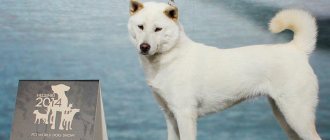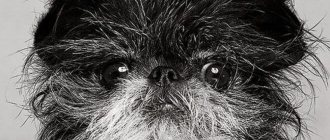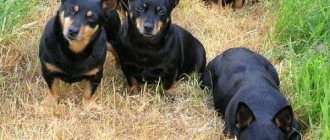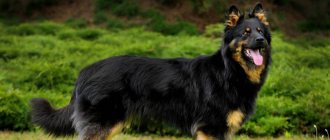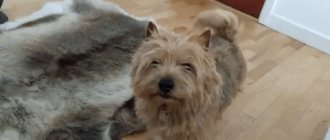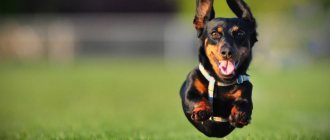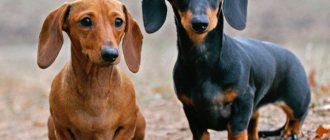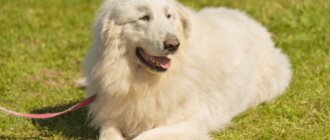History of the Dachshund breed
It is impossible to reliably trace the origin of the dachshund. Hunting dogs with short legs are depicted in drawings of Ancient Egypt and appear in ancient Greek and Roman sources.
Zoologists believe that the birthplace of the dachshund as a breed is Germany during the Roman Empire. Reason to believe so is provided by the numerous skeletons of dachshunds found in Roman settlement areas.
A dachshund is a dog that is the result of a mutation or disease. Short limbs suggest that representatives of this breed are dwarfs.
The name of the breed says everything about dachshunds and their purpose: “dachshund” comes from the German word “daxa”, meaning “badger”. Another name for the breed is “daxhund”, that is, a badger hound.
The ancestors of dachshunds are German Brackets - small hounds. Dachshunds have retained the hunting qualities inherent in Brackets, and their short limbs have made this breed indispensable for burrow hunting. The hunting dachshund is an excellent assistant in hunting animals that tend to hide in holes.
South Saxony, 16th century.
Dachshunds have not yet received a uniform standard, but have already been assessed by German landowners. Badger raids on cultivated lands are an unpleasant event.
Dachshunds helped reduce the number of aggressors by not stopping at the entrances to deep burrows. The townspeople did not lag behind the farmers. The dogs did not require much space due to their small size, and feeding them was not a problem. The 17th century is the time when dachshunds began to be bred. The first nurseries appear, representatives of the breed find more and more fans. But breeders have not yet come to a single standard. The result was the division of the breed into two directions: working and decorative dachshunds.
In 1870, the first breed standard was approved, where dachshunds are listed as dogs for hunting. In Russia in 1900, the Russian Society of Fox Terrier and Dachshund Lovers was opened. This can be considered the starting point of the Russian line of dachshunds. From that moment on, stud books were kept and exhibitions were held.
In Russia, this breed was mainly used as a companion. The most famous dachshunds are the pets of Anton Pavlovich Chekhov: Hina Markovna and Brom Isaich. Two world wars and the emergence of the Soviet system had a negative impact on the breed - in 1958, only 11 purebred individuals took part in the dog show.
Nowadays, dachshunds are not uncommon in Russia. Dog lovers know and love this breed.
Breed standard
Understanding of the dachshund's conformation has changed greatly over 150 years. The German Tekel Club (Deutsche Teckelklub) is steadily improving the document regulating the modern view of the ideal dachshund. The official FCI standard No. 148 of 2001 is currently in force.
What does a dachshund look like? A short-legged dog with a stretched body. Squat, but not rough. Deep, developed chest. Pronounced withers. Muscular limbs. The dry, elongated head of precise lines, set on a slender neck, carries itself proudly. Hanging ears, long tail.
Varieties of dachshunds by size
There are three of them:
- dachshund (as was commonly said until recently, standard),
- miniature (dwarf),
- rabbit
The difference from other breeds is that it is not the height of the dog at the withers that is taken into account, but the volume of the chest (measured with a measuring tape) and weight. The upper limit is set at 35 cm and 9 kg respectively.
The breed practices a “floating” boundary between varieties. The true size of the dachshund can only be determined after 15 months. Documentary transfer to another category is carried out after official measurements at the exhibition.
Varieties of dachshund by coat
There are also three of them, but here everything is strictly limited and there can be no transitions:
- Smooth-haired (the original version, the most numerous group).
- Wirehaired (the result of the infusion of terrier blood; it is characterized by a more stable transmission of hunting qualities).
- Long-haired (spaniel blood was deliberately used to enhance decorativeness).
Although the coats of the three types look completely different, there is a single list of breed colors. An exception is made for “hard” dogs - they most often have a “boar” (zonal) color, which is not applicable to other types of coat.
Varieties of dachshunds
The German Dachshund can come in different sizes:
- standard – height from 20 to 27 centimeters, weight up to 9 kilograms, with a chest volume of 35 centimeters;
- dwarf – height from 14 to 21 centimeters, weight from 4 to 5.5 kilograms, chest volume from 30 to 35 centimeters;
- rabbit - no higher than 15 centimeters, weighing about 3.5 kilograms, with a chest volume of up to 30 centimeters.
Only standard dachshunds can be classified as hunting dogs, the other two types are purely decorative.
Dimensions and weight
The table shows the average parameters of a dachshund :
| Variety | Weight | Chest circumference |
| Standard | Up to 9 kg The figure above is recognized as breed, but is not awarded the “excellent” rating | 35 cm |
| Dwarf (miniature) | 3.5 kg | 30-35 cm |
| Rabbit | 4-5 kg | 30 cm |
What does a dachshund look like?
The characteristics of the Dachshund breed are fully given in the standard. Even children know what a dachshund looks like: an elongated body and short legs are the distinctive features of these dogs. A dachshund in profile is a favorite plot of children's animators.
Dachshund breed standard
- Head : dry, wedge-shaped, not devoid of grace, the upper part of the head is flat, the muzzle is long, with a hump on the nose, with a smooth transition from the forehead.
- eyes : medium in size, oval in shape, set wide apart, color varies from light brown to dark brown, blue eyes are allowed in merle-colored dachshunds.
- ears : hanging, medium in size, round in shape, set high, close to the back of the head.
- Nose : with a large nose, color – black or brown, depending on color.
- Jaws : Deep, strong, with a scissor bite, close-fitting lips with slight folds at the corners.
- Neck : high, long, well developed, with a convex nape.
- Body : long, with a straight or slightly sloping back, long, muscular loin.
- Chest : pushed forward, reaching the middle of the forearm, wide.
- Belly : tucked up.
- Limbs : short, dense, muscular, hind legs set wide apart, toes tightly clenched, well developed pads and strong nails.
- Tail : long, straight or crescent-shaped, set low.
Wool
There are 3 types of breed based on coat type:
- short-haired;
- long-haired;
- Wire-haired.
The best option for keeping at home is considered to be a smooth-haired miniature dachshund, which does not require serious care, does not cause problems when shedding, but does not tolerate frost.
Long-haired dachshunds are the result of crossing short-haired individuals with spaniels; the first long-haired dachshunds were registered in 1820.
Wire-haired dachshunds have eyebrows, mustaches and a beard.
Colors
The breed has three main colors:
- black;
- brown;
- ginger.
Shades are also possible: fawn, coffee, chocolate, chestnut, golden.
There are also three color options:
- monochrome;
- two-color;
- polychrome.
Dachshunds cannot be brindle, boar or spotted. But marbled, tan and moire colors are provided for by the standard. White dachshunds are not included in the standard.
The history of the appearance of the dachshund
According to scientists, the dachshund is a descendant of ancient short dogs that people used for hunting. This theory is confirmed by the second name of the breed – Bracka. It occurs among European residents. In ancient times, brakki were short-legged dogs capable of lifting feathered game onto the wing and driving out burrowing animals. Images of squat four-legged creatures were also found on ancient Egyptian frescoes, but the further fate of these animals is not known for certain.
The dachshund appeared in Russia in the 18th century. Documents of that time indicate that taxel dogs, among other breeds, were used for royal hunting. Historians believe that they were brought from Courland by Empress Anna Ioanovna herself. The queen was a passionate fan of hunting, and these dogs were considered her favorites.
Character of the breed
“Cute dachshund” is an impression of the dog’s appearance. A much more correct phrase appears on the coat of arms of the German Dachshund Club: “Self-esteem and strong character inspire sympathy.”
The small size and unusual proportions of the dachshund should not be misleading: this is a hunter. Moreover, a hunter for whom it is vital to make quick independent decisions. Getting to a badger or fox in their own holes is a dangerous undertaking.
Dachshunds are used to making decisions without the participation of their owner. Some owners call this stubbornness. But in some cases, the dachshund is confident that it has a better understanding of the situation and how to act.
Unshakable self-confidence, self-esteem and a complete lack of admiration for the owner - these are the components of the dachshund’s character.
If a common language with a dog is found, it is difficult to imagine a more faithful and reliable comrade. A properly raised and trained dachshund is the ideal of obedience and responsiveness.
Long loneliness is the worst punishment for a dachshund. The animal will take out its grievances on the surrounding environment.
The balanced and even phlegmatic dachshund at times shows playfulness and ingenuity. There is no doubt about the intelligence of these dogs. Representatives of the breed do not accept harsh methods towards themselves. The dachshund will express dissatisfaction instantly: disobedience, ignoring, damaging property - this is not a complete list of the actions of an offended dachshund.
Breeders advise choosing nicknames for your dachshund that reflect the cheerful disposition of the breed.
Dachshunds are picky about the comfort of their own existence. She will not trust anyone to choose a place for a bed. You can be sure: if the dachshund has chosen a place, then it is definitely the warmest in the house, without drafts or other inconveniences. Representatives of the breed love affection, often lie on the owner’s lap, and climb under the blanket.
At the same time, representatives of this hunting breed love walks and new experiences and keep company in any active activity.
Pros and cons of the breed
Adaptability to life with humans makes the dachshund a good companion, but this dog also has disadvantages.
Pros:
- Can live in an apartment.
- Cleanliness.
- Easy care.
- Lack of fear.
- Devotion.
- Playfulness and tact.
- Good attitude towards children.
Minuses:
- Stubbornness.
- Long memory for grievances.
- The difficult process of education.
- Demanding activity.
- The dachshund bites - it can bite both its own and strangers.
- Serious tendency to genetic diseases.
Relationship with other pets and children
Modern dachshunds are sociable animals with enviable tact and adaptability. The puppy will definitely make friends with other pets, if there are any in the house, and will welcome new family members into the company.
The moment of acquaintance is very important for further relationships between animals. You need to introduce your dachshund to a new friend carefully, making sure that the pets do not immediately hurt each other. If your first meeting is successful, you can say with confidence that the relationship will improve.
Dachshunds love children. They will not become nannies and will not tolerate the child’s provoking behavior either. But, if children follow simple rules and do not hurt the dog, there is nothing to fear. The dachshund will be good company and a participant in children's games.
Character traits
The dachshund is widespread throughout the world, and the breed is popular not only among hunters. Ordinary city residents also happily breed these dogs; their small size allows them to be kept even in a small area. The reason for such a person’s love for this breed is its extraordinary intelligence and attractiveness. A neat little dog that is easy to train - an ideal option for families with children, for retirees, and for active young people. The dog will feel great anywhere and everywhere. Some breeders claim that dachshunds even have a sense of humor.
For hunters, a dachshund is a reliable and faithful companion that you can safely take with you into the forest. The pet will do an excellent job of catching burrowing animals: badgers, foxes, rabbits. But for all its obedience, the dog retains a certain degree of independence and in difficult situations is able to make decisions independently. If we add natural liveliness, curiosity and an active mind to these qualities, then you simply cannot find a better companion among dogs.
The breed's psyche is stable; aggression is not typical for animals. The character is calm. But the dachshund behaves warily towards strangers - it has excellent watchdog qualities. A pet with proper upbringing will never behave inappropriately; it reacts calmly to small children and other pets.
The dachshund does not tolerate loneliness well. This is a very tactful, polite, but sociable dog. She needs daily communication with a person, otherwise severe depression is possible. For people who are too busy and spend a lot of time at work, it is better to choose a more phlegmatic breed.
The undeniable advantages of the dachshund include its cleanliness. The dog will never spoil the house, even if he suffers greatly. Puppies quickly get used to walking and let the owner know about their needs in time. On the street, a well-mannered dog will not get into the mud and will not eat from the trash heap. Their behavior is even characterized by a certain aristocratic disgust. This quality of a pet is especially important for families with small children.
Training and education
Dachshunds are smart and quick-witted. They very quickly understand the benefits of permissiveness. Raising a small dachshund should begin immediately. It's hard to refuse a pet with plaintive eyes if he wants to bask under your side. But if there is no desire to share the family bed with a dachshund, you will have to refuse.
If a dachshund is allowed to do something, it is almost impossible to prohibit it in the future.
Socialization, rules of behavior and simple commands are the task for the first months of coexistence. Introduce the baby to the world around him and the creatures that inhabit it, decide on a place to sleep and toilet, learn a name, and develop rules of behavior.
Finding positive motivation for a dachshund is not a problem. They love to eat delicious food, so their favorite treat will be a good help in raising a puppy.
Training should begin with the simplest commands: “Fu”, “No”, “Place”, “Sit”, “Stand”.
When the puppy is six months old, he will try to find the boundaries of what is permitted. During this period, the owner will need patience and endurance. You cannot break down, yell at the dog, or use physical punishment.
Commands that require static behavior are difficult for active dachshunds, but they cannot give up.
There is a set of rules for training a dachshund:
- Give a command only if you are sure that the dachshund will carry it out.
- Training is carried out on an empty stomach.
- You cannot repeat the command - it is pronounced clearly and confidently, once.
- The calmness and confidence of the owner is the key to a successful lesson.
- It is forbidden to hit, shout, or drag the dog.
- Studying for too long will not lead to success.
- Consistency is very important. What is prohibited and what is permitted should not change.
- To consolidate the result, the command is repeated several times.
Raising and training a dachshund is a difficult period. But the success achieved pays off the time and stress.
Hunting
The dachshund is a burrowing dog, its purpose is to lure their inhabitants out of holes under the hunter’s shot, or to retrieve shot game from places inaccessible to the hunter. For example, a swamp duck.
The dachshund is careful and persistent when hunting. These are exactly the qualities that are necessary to successfully complete a task and save your own life. In its hole, any animal will defend itself to the last. The dachshund’s task is not to expose itself to the claws and teeth of a badger driven to rage, but to lure it out of the hole.
The dachshund makes decisions on its own what to do so as not to be buried in a dead end, not to fall into the strong paws of a badger, or into the teeth of a fox.
During the cold season, hunters dress their dachshunds in insulated overalls to avoid colds. Vaccinations and post-hunt checkups will protect your dog from infections.
Training
Toilet training a puppy is a difficult task. The baby's fast metabolic process contributes to frequent urges, and he may not have time to run. Until vaccinations are completed, the puppy goes to the toilet at home. Scraps of newspapers are used to mark the location.
A small dachshund needs walks at least four times a day. If you comply with this condition and show persistence, you can train your dog to be patient until walking by 4-5 months; if not, then a home toilet can last up to a year.
It is necessary to educate and establish rules of behavior from the first day the puppy is at home. If he notices that he can neglect the owner’s demands with impunity, he will definitely take advantage of this.
We advise you to read: Bolonka dog breed
Little dachshunds will climb into the warmest and most comfortable places. If your plans do not include sharing a bed and blanket with your pet, you need to stop this behavior immediately by transferring the baby who wants to pamper himself to his own bed, repeating the “Place” command. The pet must clearly understand what exactly the owner is dissatisfied with.
Dachshunds, by their nature, actively respond to external factors, so it would be a good idea to conduct training outside so that the puppies get used to noise and recognize commands from it.
When training, it is preferable to motivate the dog with a favorite treat: a dachshund who loves to eat will do anything to get it. And you need to stay away from severity, rudeness and violence: such methods are not for dachshunds.
Representatives of this breed are able to learn and use all possible commands. The speed and their implementation depends on a properly constructed process.
Care and maintenance
The dachshund is undemanding in terms of care and can live in both an apartment and a house. But the short hair of smooth-haired dachshunds does not allow these dogs to be kept outside.
Baby dachshunds are curious and try everything, so when getting a pet, you need to take care of both the interior and clothing. It is better to put everything valuable and important out of the puppy’s reach.
Dachshunds have high activity requirements. You need to be prepared for long walks so that your pet does not gain excess weight. In the cold season, you can use overalls. But weather conditions do not affect the walking schedule - walking will take place in any weather. A dachshund needs at least two 45-minute walks a day. It is not recommended to let your dog off the leash: it can get carried away with the hunt and run away without responding to commands.
A regular collar is not suitable for a dachshund: it will easily take it off. The way out of the situation is a vest-harness.
Hygiene
- Water procedures - no more than once every three months. It is not recommended to wash puppies until they are six months old.
- Trim the nails twice a month, unless they become sharpened during walks.
- Eyes - washed with a soft cloth soaked in warm water.
- Dachshund teeth – require regular brushing to avoid tartar and plaque.
- The Dachshund's ears are cleaned with a swab containing hydrogen peroxide once a month, and inspected after each walk. Long ears collect debris, dirt and mites. Do not use cotton swabs - there is a risk of damaging your ear during the procedure. If there are signs of discharge or an unpleasant odor, it is better to immediately contact a veterinarian. Dachshunds' ears cannot be cropped.
Grooming
- To care for the hair of short-haired dachshunds, you will need a few minutes a day and a brush mitt. A regular soft cloth will also work.
- Long-haired individuals will have to be combed with a comb and a stiff brush. Twice a week, during molting - every day. Trimming is also important for this look: between the toes and around the pads, in the ears and groin.
- Wire-haired dachshunds will need to wipe their mustaches and beards after every meal. Brush regularly. During molting - daily.
Estrus, mating, pregnancy, childbirth
It is recommended to breed a dachshund no earlier than 2 years of age. Early pregnancy will have a bad effect on both the mother and the offspring.
A month before mating, it is advisable to undergo a comprehensive examination and treat the dachshund for parasites and worm it. After the start of estrus, the dachshund is ready for mating on day 12-15.
A female dachshund bears puppies for 62 days. A period of 53 to 72 days is considered normal. It is possible to accurately determine pregnancy only a month after mating, when the life is rounded, the nipples are enlarged and the skin around them is lightened.
In the second half of pregnancy, it is advisable to slightly increase the dog’s diet, but not to overdo it - excess weight will have a bad effect on health. A pregnant dachshund needs more protein. During this period, the dachshund itself determines how long to walk: it asks to go home. Excessive activity is not needed at this time.
If labor begins early or late, it is better to call a veterinarian for help. No medications are needed. During the normal course of the process, they are not needed, and the veterinarian will arrive with a suitcase.
Before giving birth, the dachshund begins to worry, look for a place or cuddle up to the owner. Immediately after birth, it is advisable to give the mother water or fermented milk products to drink.
How to toilet train
Dachshunds are clean animals, so there are no problems with litter box training. It is enough to take the baby to the place chosen for the toilet once every few hours - after sleep or food. The place must be permanent. A clear sign of the desire to go to the toilet is the puppy's restlessness.
In the future, when the puppy goes for walks, it is necessary to approve of relieving himself on the street and react negatively to going to the litter box. The tray is subsequently removed.
What toys do you need?
Dachshunds are not averse to tasting anything, so they need toys. Balls are suitable for outdoor use, and bones of different sizes are suitable for home use. There are also certain requirements for toys:
- the toy should not consist of small fragments - there is a high risk that the dog will swallow the bitten off piece;
- all toys should be made from natural materials so as not to harm the pet’s health;
- Human plush toys and dolls are not suitable for a dog: she will chew them and the filling will end up in her stomach.
Features of nutrition and feeding
It is important to remember that the Dachshund is a gourmet dog, and problems with gaining excess weight are present in this breed.
Do not overfeed! It is better to feed puppies with natural products, and in adulthood they can be switched to dry food of at least premium class.
The natural diet of a dachshund includes the following products:
- lean meat;
- sea fish fillet;
- low fat cottage cheese;
- rice, buckwheat, rolled oats;
- vegetables;
- boiled eggs.
Dachshunds do not digest milk in its pure form.
Natural feeding requires mineral supplements. Which ones exactly - it is better to ask the advice of the veterinarian observing the dog.
Spicy, smoked, highly salted, pickled, sweet, and flour foods should not be given to your dachshund. Also, do not indulge in begging and share food from your table.
Nutritional features - how to feed correctly?
Since the dog is prone to obesity, the feeding measure is based on weight. The norm is 8-9 kg for females and 10-12 kg for males.
In terms of natural food, it is advised to adhere to:
- meat (turkey, beef, lamb);
- fish (sea);
- cereals (rice, buckwheat, oats, rolled oats, etc.);
- fermented milk products (cottage cheese, sour cream);
- vegetables with fruits.
As a rule, a third of the diet consists of meat. However, it doesn’t hurt to be careful here.
IMPORTANT!
For example, fatty pork can lead to intestinal upset, and chicken meat can lead to allergies.
The dachshund is a somewhat stubborn and arrogant animal that does not hesitate to steal from the table . If such an opportunity is not foreseen, then it is time for the pet to resort to begging.
By the way, dachshunds are wonderful actors. It’s time for a dog to eat a hearty meal and immediately start whining pitifully and making eyes.
Diseases and life expectancy
The main problems of dachshunds are related to excess weight: obesity and spinal problems. In addition to this, there are several more genetic diseases that dachshunds are susceptible to:
- osteoporosis;
- acanthosis nigricans;
- cataract;
- diabetes;
- problems of the cardiovascular system;
- diseases of the genitourinary system.
In addition, dachshunds are susceptible to physical injury. The specific structure of the body causes increased stress on the spine. It is advisable to limit jumping and overcoming obstacles.
The average lifespan of a dachshund is 12-13 years. But proper care, diet and keeping in good conditions can add several years to your pet’s life.
How to choose a puppy and how much does a dachshund cost?
There are many varieties of the breed, so you need to decide which one you want to get – size, coat, color. Based on these parameters, a nursery is selected. It wouldn’t hurt to read reviews about it.
When choosing a puppy, you should pay attention to the following aspects:
- correct bite;
- absence of dewclaws (fifths);
- the tail is not deformed;
- absence of hernias;
- easy movements, without deviations in gait;
- absence of white spots on the coat;
- no discharge from the eyes and ears;
- the coat is shiny, without bald spots;
- well-fed, but not overweight;
- curiosity and activity;
- a good appetite.
The cost of an ordinary dachshund puppy, without documents and pedigree, is only a few thousand rubles. This option is suitable if you are looking for a pet.
A puppy with a pedigree that meets the standards will cost from 20 thousand rubles.
